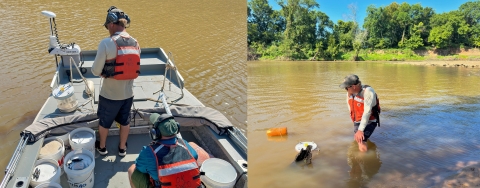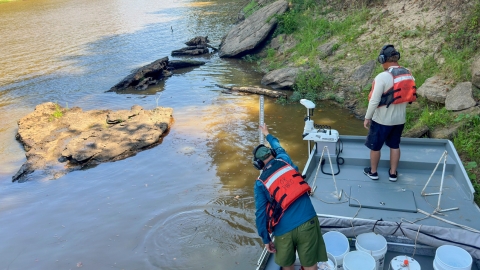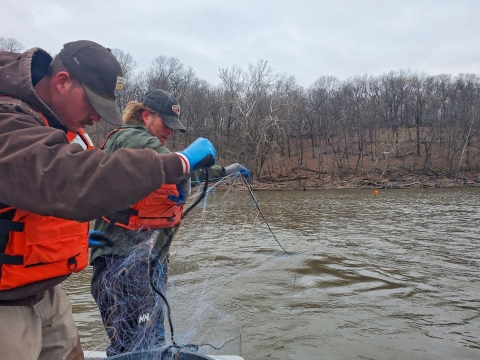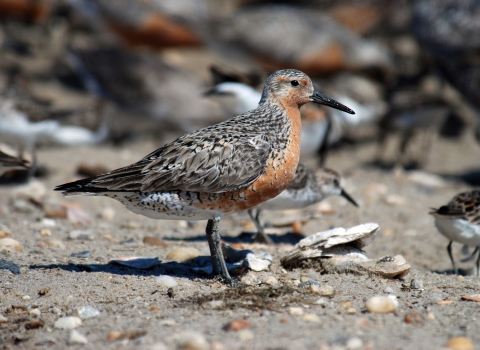Finding your path toward a career in conservation is challenging. We can all look back to pivotal moments in our journey; for many of us, that internship was the launching point for where we are. That is precisely what Chuck Taylor, an intern based out of the Oklahoma Fish and Wildlife Conservation Office (OKFWCO), has in mind for what is shaping up to be a bright future.
Taylor is one of many Bureau of Indian Affairs (BIA) WaterCorps interns spread across the U.S. Fish and Wildlife Service. The program is a partnership between the BIA and Stewards Individual Placement Program dedicated to providing high-quality technical skills to Tribal youth in the water resources field.
Taylor's path is one of evolution and deep roots in a love for nature. Growing up as a fourth-generation land manager of family tribal land in southern Oklahoma shaped Taylors interests and passions. A prime example of this is listening to Taylor talk about his love for wild turkeys and the underrated beauty that they possess.
"I love to watch their behavioral interactions with their environment along with all the iridescent colors they display," said Taylor. "You would never know how many colors they truly have until you spend time in the outdoors observing them in the sunlight while they interact with their surroundings."
After completing a degree in physical education, Taylor went on to become a science teacher. That experience enabled him to gain a foundational understanding of science concepts and formulate an interest in research. Teaching also shaped the tools with which Taylor is able to communicate science to those from varying backgrounds, cultures, and learning styles.
OKFWCO Experience
Taylor has many tasks assigned to him at the OKFWCO. As a part of the internship, Taylor also completed his Motorboat Operator Certification Course and Airboat training. In addition to maintenance and repair work, Taylor leads efforts to clean and disinfect equipment to prevent genetic contaminations of future collections.
Having sterilized equipment is key to environmental DNA (eDNA) work or the collection of a variety of environmental samples such as soil and water. eDNA is particularly important as it is used to determine the presence of invasive carp at various locations on the Red River, located along the Oklahoma- Texas border, and to determine how far upstream these carp are completing a successful spawn.
"My favorite part of the role has been monitoring and observing remote locations on the dynamic, ever-changing Red River while aiding efforts to evaluate the current level of invasion by the Bighead and Silver Carp," said Taylor.
Taylor also aids efforts in the acoustic sound monitoring of invasive carp by designing and engineering gear to deploy acoustic receivers in the river system. Monitoring the flows of the Red River and its tributaries allows for planning on how and where effective sampling can be done.
"Chuck Taylor's work ethic is superior; you ask him to complete something, and he does it without supervision to the highest level, whether it is biological or mechanical," said Brian Fillmore, OKFWCO project leader. Chuck's ability to learn with little instruction is a wonderful attribute to supervise."
Learning Experiences
In addition to the experience gained at the OKFWCO, Taylor has also been able to work with numerous partners such as the Oklahoma Department of Wildlife Conservation (ODWC), Oklahoma Ecological Services, Tishomingo National Fish Hatchery, U.S. Geological Survey (USGS), and Mora National Fish Hatchery. The opportunity led to completing seine net surveys on the South Canadian River from Amarillo, TX, to Ada, OK. These efforts are completed annually to monitor the threatened Arkansas River Shiner and the endangered Peppered Chub presence in the South Canadian River.
Taylor also aided in ODWC's electrofishing efforts to collect Blue Suckers from the Red River. This was done to learn techniques for potential reintroduction efforts in the Arkansas River system. Taylor also learned from USGS scientists who demonstrated several collection and monitoring techniques with various floating gill nets, block nets, kayak drones, underwater sound devices, and commercially available forward-facing sonar.
Working with the Tishomingo National Fish Hatchery, Taylor set and pulled gill nets with the OKFWCO to collect Paddlefish broodstock broodstock
The reproductively mature adults in a population that breed (or spawn) and produce more individuals (offspring or progeny).
Learn more about broodstock . From there, Taylor was involved with spawning these fish collected to produce young that would eventually grow to 12 inches before being reintroduced into Caddo Lake in northwest Texas. Taylor also visited the Mora National Fish Hatchery in New Mexico and aided in their efforts to spawn the endangered Gila Trout.
"Chuck is the type of intern you find ways to hire," said Fillmore. "The OKFWCO is continuously looking for an opportunity to hire Chuck on a permanent status. He would be a valuable asset to our small team. Chuck not only has an excellent work ethic, but he is also very safety conscious. This is very important on a small team that works with fluctuating rivers, changing weather patterns, and powerful potentially dangerous equipment such as airboats."
As Taylor continues to work through the remaining months of his internship and reflect on its impact, it is clear that the future is bright for him. Ultimately, Taylor would love to find a role working in southeastern Oklahoma focused on wildlife or aquatic management.







